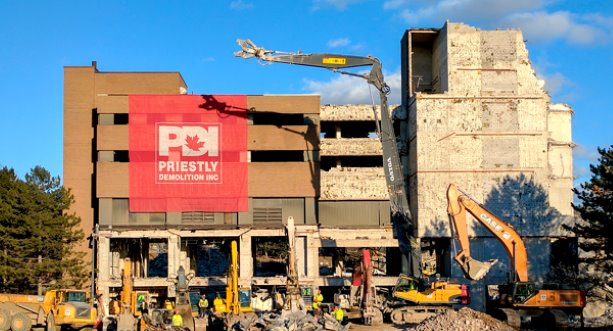After cleaning up last year with their debut entries, Priestly Demolition is bringing home two more awards from the World Demolition Summit 2017.
Priestly made the short list in three categories, Contract Under $1 million — St. Michael’s Hospital stair demo; in the Recycling and Environmental Contract category for the Humber River Hospital; and abatement and the Port Severn bridge demolition on Highway 400.
They won for the two hospital projects.
The wins follow last year’s conference in Florida where they were tops in three categories including best overall for their Nipigon Bridge project.
"The St. Michael’s Hospital Cardinal Carter South stairwell demolition was one of the most complex we’d done in years," says Brian Priestly. "It was a 17-floor tower used for emergency egress. They built the new Peter Gilgan Patient Care Tower adjoining the existing hospital and it had to come down."
The problem wasn’t so much the demolition, it was the confines of space and the juxtaposition of working next to an active hospital.
"We had to make sure we could stop if they needed to work in one of the operating rooms free of noise and vibration," he says.
Working closely with special liaisons at the hospital, crews set about taking down the 410 stairs and 2,317 cubic metres of concrete over seven months, starting in early 2017.
There were even vibration monitors throughout the hospital and a process set up to track infections, critical care equipment and ensure patient and staff safety, with ear plugs and ear muffs issued to those in close approximation to the demolition activity.
There were some 200 meetings between the hospital and demolition crews and Priestly says they worked flexible hours to accommodate patient care whenever possible.
Demolition went from the top down, using a Brokk 100, a remote controlled electric demolition robot along with an Atlas Copco hammer.
The concrete slab was broken into crane sized bites, the rebar was cut into sections and poured into a dump trailer.
To optimize crane capacity, maximum lifts were planned onsite by measuring and laying out cut lines on beams, columns and slab sections.
"I don’t know exactly what we recycled off that job but I’m pretty sure it was more than 90 per cent," says Priestly.
Logistically, part of the problem, he says, is that nothing was level on the stair tower so they had to build and install a working platform that could be moved down as work progressed.
At the 12th floor Priestly brought in a Hitachi 27 because the footprint was larger and work continued in parallel. The job also required temporary shoring posts to support the mini excavator and rubble load. Clean up was by Bobcat and manual labour.
St. Michael’s is already planning to demolish the Shuter Wing next year as part of the new Slaight Family Emergency Department.
Priestly was also the go-to demolition team for Daniels Humber River on the former Keele Street Humber River Hospital.
The seven-storey east tower, nine-storey west tower, power plant and service tunnel all had significant amounts of asbestos, making things more complicated.
Before structural demolition the entire decommissioned hospital had to be abated at an Asbestos Abatement Type 3 level, followed by an interior stripping phase, removal of interior walls and electrical and mechanical elements throughout.
To speed things along Priestly demolished the west tower while abatement was underway on the east tower.
The crew set a lofty goal for recycling the materials and the challenges included how best to separate the brick veneer from the concrete to divert it all from landfill.
Priestly says they used the Volvo 700 high-reach excavator to precisely extract materials, recycling the red brick separately.
The project took just over a year with 50 employees working two shifts at times.
It was another winter job involving heights and an aggressive schedule compounded by being in the middle of a residential neighbourhood where noise, dust and vibrations were of concern.
"I think we salvaged more than 90 per cent of materials for recycling," says Priestly, noting they recovered 850 metric tonnes of steel and rebar just from the concrete processing activity.
In total, there was 3,550 metric tonnes of steel, 4,267 metric tonnes of brick, 323 metric tonnes of asphalt, 337 metric tonnes of soil remediated, 1,264 florescent light tubes and 230 smoke detectors recycled.
Another 1,590 metric tonnes of construction and demolition waste was trucked for further processing off site.
Some 38,000 metric tonnes of concrete was fed into a Lippmman 4800 Impact Crusher to generate two inch chunks, which were used throughout the site for backfill on roads, lay down areas and other working areas, eliminating the need for 2,000 dump truck trips, Priestly states.











Recent Comments
comments for this post are closed